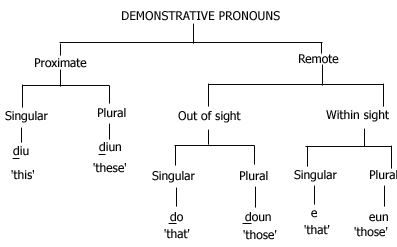dour |
yo s s |
|
| 1 |
2 |
|
those (out of sight) |
came |
|
| 1 |
2 |
|
e |
miun |
yo s s |
| 1 |
2 |
3 |
those |
men (within sight) |
came |
| 1 |
2 |
3 |
eun |
yo s s |
|
| 1 |
2 |
|
those (within sight) |
came |
|
1
|
2
|
|
|
The classification of demonstrative pronouns may be shown as
|
|

|
3.1.4.
|
Cases |
As Jespersen (1924) has rightly
pointed out, "cases form one of the most irrational part
of language in general". The following cases have been
identified in Purki language: ergative, nominative,
accusative, instrumental, sociative, dative, ablative,
benefactive, locative and genitive.
|
| 3.1.4.1.
|
Nominative |
The nominative case denotes the
subject of the sentence. Literally it means naming the
subject. In other words, it is the case which expresses fthe
subject. The label nominative is used to refer to the subject
only when the berb is intransitive. -Ę
is the nominative case morpheme i.e. the nominative is
unmarked when the verb is intransitive.
|
 a a |
gondeya |
yo s s |
| 1 |
2 |
3 |
I |
came |
yesterday |
| 1 |
3 |
2 |
 a a |
so |
|
| 1 |
2 |
|
I |
went |
|
1
|
2
|
|
|
3.1.4.2.
|
Ergative |
The ergative case also refers to the
subject of the sentence. The difference between nominative
case and ergative case is the presence of
intransitive/transitive verb. If the verb is transitive, the
case denoting the subject is called ergative case. -is
identified as the ergative casee in Purki.
|
|
|